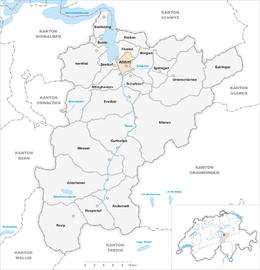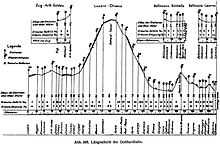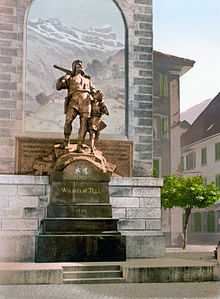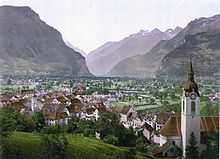Altdorf, Switzerland
| Altdorf | ||
|---|---|---|
|
| ||
| ||
 Altdorf | ||
|
Location of Altdorf  | ||
| Coordinates: 46°52′N 8°38′E / 46.867°N 8.633°ECoordinates: 46°52′N 8°38′E / 46.867°N 8.633°E | ||
| Country | Switzerland | |
| Canton | Uri | |
| District | n.a. | |
| Government | ||
| • Mayor | Urs Kälin | |
| Area[1] | ||
| • Total | 10.21 km2 (3.94 sq mi) | |
| Elevation | 458 m (1,503 ft) | |
| Highest elevation (Eggberge) | 1,720 m (5,640 ft) | |
| Lowest elevation (Wildried) | 432 m (1,417 ft) | |
| Population (Dec 2013[2]) | ||
| • Total | 9,000 | |
| • Density | 880/km2 (2,300/sq mi) | |
| Postal code | 6460 | |
| SFOS number | 1201 | |
| Surrounded by | Attinghausen, Bürglen, Flüelen, Seedorf | |
| Twin towns | Altdorf b. Nürnberg (Germany) | |
| Website |
www SFSO statistics | |
Altdorf (German for "old village") is the capital of the Swiss canton of Uri. The municipality covers an area of 10.23 square kilometers (3.95 sq mi) and is located at a height of 462 meters (1,516 ft) above sea-level, to the right of the river Reuss.
The official language of Altdorf is (the Swiss variety of Standard) German, but the main spoken language is the local variant of the Alemannic Swiss German dialect.
Location

Altdorf is 55 kilometers (34 mi) from Lucerne by the Gotthard railway and 28 kilometers (17 mi) from Göschenen. Its port on the Lake of Lucerne, Flüelen, is 2 miles (3.2 km) miles distant. There is a stately parish church, while above the little town is the oldest Capuchin convent in Switzerland (1581).
The municipality is located south of the Lake of Lucerne, and along the eastern side of the Reuss River. Additionally it is located on the major transportation line through the Gotthard Pass and along the Gotthard rail line.
Geography
Altdorf consists of the town proper in the Reuss valley and the scattered hamlets of Eggberge on a high terrace above the town. It adjoins Attinghausen und Seedorf in the west, Flüelen in the north, Bürglen in the east and south, and Schattdorf in the south.
The municipality has an area, as of 2006, of 10.2 km2 (3.9 sq mi). Of this area, 35.9% is used for agricultural purposes, while 39.3% is forested. Of the rest of the land, 23% is settled (buildings or roads) and the remainder (1.9%) is non-productive (rivers, glaciers or mountains).[3] In the 1993/97 land survey, 37.2% of the total land area was forested. Of the agricultural land, 0.7% is used for farming or pastures, while 35.2% is used for orchards or vine crops. Of the settled areas, 11.3% is covered with buildings, 2.6% is industrial, 0.8% is classed as special developments, 1.5% is listed as parks and greenbelts and 6.7% is transportation infrastructure. Of the unproductive areas, 1.1% is unproductive flowing water (rivers), there is 0.6% that is too rocky for vegetation, and 0.2% is other unproductive land.[4]
History

The earliest evidence of a settlement in Altdorf are several La Tène era bronze ax-heads and iron tools from the 3rd century BC. The people that settled in this region initially settled in the forest, and expanded toward the banks of the Reuss river. When the Reuss periodically flooded, the low lying settlements were destroyed and the inhabitants were driven back to the "old town", a possible source of the name Altdorf.[5]
Following the collapse of the Roman Empire the local Gallo-Roman population of Altdorf began to mix with the Germanic Alamanni during the 7th century. The earliest evidence of this is the grave (dated to 670–680) of an armed horseman located in the local St Martin's Church.[6]
The current town was first mentioned in 1223 as Alttorf. During the 16 to 19th centuries it was known simply as Uri.[7]
Altdorf is best known as the place where, according to the legend, William Tell shot the apple from his son's head. This act by tradition happened on the market-place, where in 1895, at the foot of an old tower (with rude frescoes commemorating the feat), there was set up a fine bronze statue (by Richard Kissling of Zürich) of Tell and his son. In 1899 a theatre was opened close to the town's center for the purpose of performing Schiller's play of Wilhelm Tell.
The same year a new carriage-road was opened from Altdorf through the Schächental and over the Klausen Pass (1,948 meters (6,391 ft)) to the village of Linthal (46 kilometers (29 mi)) and so to Glarus.
In 1906, the Altdorf–Flüelen tramway was constructed to connect the centre of Altdorf with Fluelen railway station. The electric tramway operated until 1951, when it was replaced by a bus service.[8]
Demographics

Altdorf has a population (as of 31 December 2013) of 9,000.[2] As of 2007, 13.5% of the population was made up of foreign nationals. Over the last 10 years the population has decreased at a rate of −0.4%. Most of the population (as of 2000) speaks German (88.3%), with Serbo-Croatian being second most common (4.2%) and Italian being third ( 2.5%).[3] As of 2007 the gender distribution of the population was 48.4% male and 51.6% female.[9]
In Altdorf about 65.2% of the population (between age 25–64) have completed either non-mandatory upper secondary education or additional higher education (either university or a Fachhochschule).[3]
Altdorf has an unemployment rate of 1.45%. As of 2005, there were 137 people employed in the primary economic sector and about 49 businesses involved in this sector. 1,748 people are employed in the secondary sector and there are 77 businesses in this sector. 3,585 people are employed in the tertiary sector, with 403 businesses in this sector.[3]
Historical population
| year | population | Swiss citizens | % German Speaking | % Roman Catholic |
|---|---|---|---|---|
| 1600 | ca. 3,100 | |||
| 1629 | ca. 1,500 | |||
| 1650 | ca. 3,000 | |||
| 1743 | 3,025 | |||
| 1799 | ca. 2,000 | |||
| 1837 | 1,903 | |||
| 1850 | 2,112 | 2,088 | ||
| 1880 | 2,906 | 2,734 | 97.9% | 96.0% |
| 1910 | 3,854 | 3,515 | 94.2% | 93.6% |
| 1930 | 4,240 | 3,984 | 94.7% | 92.0% |
| 1950 | 6,576 | 6,236 | 94.5% | 88.7% |
| 1970 | 8647 | 7,659 | 89.7% | 89.4% |
| 1990 | 8,282 | 7,158 | 88.0% | 84.3% |
source:[7]
Historisches Museum and the Haus für Kunst Uri
In 1905 a Museum was opened on Gottardstrasse just south of the centre of the town that houses a collection of local antiquities, weapons and regional furniture, as well as a collection of portraits of important Uri citizens, including fine ones by the Andermatt-born Felix Maria Diogg (1762–1834). There are several paintings here by the Swiss-born American artist Adolfo Müller-Ury (1862–1947) whose family came from Hospental, including portraits of Pope Pius X, Pope Pius XI, Cardinal Merry del Val, the artist's father Alois Muller, his uncle Domherr Josef Muller, and a large allegorical work Alpenrose und Edelweiss. The museum was extended in the 1990s.
Recently the town has established the Haus für Kunst Uri at Herrengasse 2 in a partly converted historic house with a large contemporary extension creating an attractive exhibition space. The work of Swiss and international contemporary artists from Uri is exhibited here, and they sometimes have exhibitions of earlier historical art.
Climate
Between 1961 and 1990 Altdorf had an average of 133.7 days of rain per year and on average received 1,099 mm (43.3 in) of precipitation. The wettest month was August during which time Altdorf received an average of 135 mm (5.3 in) of precipitation. During this month there was precipitation for an average of 13.2 days. The month with the most days of precipitation was June, with an average of 14.4, but with only 127 mm (5.0 in) of precipitation. The driest month of the year was February with an average of 66 mm (2.6 in) of precipitation over 13.2 days.[10] According to the Köppen Climate Classification system, Altdorf is classified as Cfb, or Marine West Coast Climate.[11]
| Climate data for Altdorf (1981-2010) | |||||||||||||
|---|---|---|---|---|---|---|---|---|---|---|---|---|---|
| Month | Jan | Feb | Mar | Apr | May | Jun | Jul | Aug | Sep | Oct | Nov | Dec | Year |
| Average high °C (°F) | 4.3 (39.7) |
5.7 (42.3) |
10.5 (50.9) |
14.6 (58.3) |
19.5 (67.1) |
22.0 (71.6) |
24.2 (75.6) |
23.4 (74.1) |
19.4 (66.9) |
14.9 (58.8) |
8.8 (47.8) |
5.3 (41.5) |
14.4 (57.9) |
| Daily mean °C (°F) | 1.1 (34) |
2.0 (35.6) |
5.7 (42.3) |
9.2 (48.6) |
13.8 (56.8) |
16.6 (61.9) |
18.6 (65.5) |
17.9 (64.2) |
14.5 (58.1) |
10.5 (50.9) |
5.2 (41.4) |
2.3 (36.1) |
9.8 (49.6) |
| Average low °C (°F) | −2.1 (28.2) |
−1.7 (28.9) |
1.3 (34.3) |
4.6 (40.3) |
8.8 (47.8) |
11.9 (53.4) |
14.1 (57.4) |
13.8 (56.8) |
10.6 (51.1) |
6.8 (44.2) |
2.1 (35.8) |
−0.8 (30.6) |
5.8 (42.4) |
| Average precipitation mm (inches) | 68 (2.68) |
65 (2.56) |
78 (3.07) |
84 (3.31) |
113 (4.45) |
132 (5.2) |
145 (5.71) |
149 (5.87) |
109 (4.29) |
77 (3.03) |
86 (3.39) |
79 (3.11) |
1,185 (46.65) |
| Average snowfall cm (inches) | 17.7 (6.97) |
16.9 (6.65) |
6.8 (2.68) |
0.8 (0.31) |
0 (0) |
0 (0) |
0 (0) |
0 (0) |
0 (0) |
0.7 (0.28) |
6.3 (2.48) |
12.6 (4.96) |
61.8 (24.33) |
| Avg. precipitation days (≥ 1.0 mm) | 9.2 | 8.7 | 10.8 | 10.3 | 12.5 | 14.0 | 13.7 | 12.9 | 10.2 | 8.7 | 9.7 | 10.1 | 130.8 |
| Avg. snowy days (≥ 1.0 cm) | 3.9 | 3.5 | 2 | 0.1 | 0 | 0 | 0 | 0 | 0 | 0 | 1.4 | 2.9 | 13.8 |
| Average relative humidity (%) | 81.9 | 78.6 | 73.9 | 71.2 | 71.7 | 73.9 | 74.9 | 78.3 | 79.8 | 81.5 | 82.1 | 83.8 | 77.6 |
| Mean monthly sunshine hours | 44 | 75 | 116 | 132 | 149 | 152 | 169 | 153 | 132 | 106 | 57 | 34 | 1,319 |
| Source: MeteoSwiss [12] | |||||||||||||
International relations
Twin towns – sister cities
Altdorf is twinned with:
 Altdorf bei Nürnberg, Germany (since 1971)
Altdorf bei Nürnberg, Germany (since 1971)
Transport
Altdorf is served by the Altdorf station, situated within the municipality and on the Gotthard railway.
References
 This article incorporates text from a publication now in the public domain: Chisholm, Hugh, ed. (1911). "Altdorf". Encyclopædia Britannica (11th ed.). Cambridge University Press.
This article incorporates text from a publication now in the public domain: Chisholm, Hugh, ed. (1911). "Altdorf". Encyclopædia Britannica (11th ed.). Cambridge University Press.
Notes
- ↑ Arealstatistik Standard - Gemeindedaten nach 4 Hauptbereichen
- ↑ 2.0 2.1 Swiss Federal Statistics Office – STAT-TAB Ständige und Nichtständige Wohnbevölkerung nach Region, Geschlecht, Nationalität und Alter (German) accessed 18 August 2014
- ↑ 3.0 3.1 3.2 3.3 Swiss Federal Statistical Office accessed 8 September 2009
- ↑ Canton Uri – Ground use statistics (German) accessed 8 September 2009
- ↑ Altdorf website-History-First Settlement accessed 22 November 2008 (German)
- ↑ Altdorf (UR) Early History in German, French and Italian in the online Historical Dictionary of Switzerland.
- ↑ 7.0 7.1 Altdorf (UR) in German, French and Italian in the online Historical Dictionary of Switzerland.
- ↑ "Altdorf–Flüelen". www.eingestellte-bahnen.ch. Retrieved 2012-09-17.
- ↑ Uri Population statistics (German) accessed 8 September 2009
- ↑ "Temperature and Precipitation Average Values-Table, 1961–1990" (in German, French, and Italian). Federal Office of Meteorology and Climatology – MeteoSwiss. Retrieved 8 May 2009., the weather station elevation is 438 metres (1,437 ft) above sea level.
- ↑ Climate Summary for Altdorf, Switzerland
- ↑ "Climate Norm Value Tables". Climate diagrams and normals from Swiss measuring stations. Federal Office of Meteorology and Climatology (MeteoSwiss). Retrieved 23 January 2013. The weather station elevation is 438 meters above sea level.
External links
- (German) Official website
 Media related to Altdorf at Wikimedia Commons
Media related to Altdorf at Wikimedia Commons- Altdorf (UR) in German, French and Italian in the online Historical Dictionary of Switzerland.
| |||||||||||||
| ||||||||||||||
